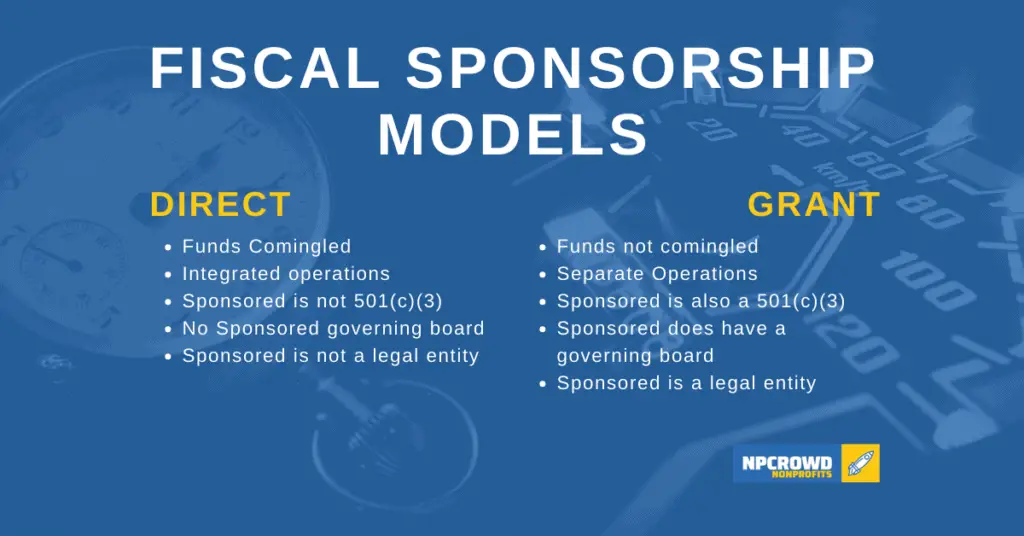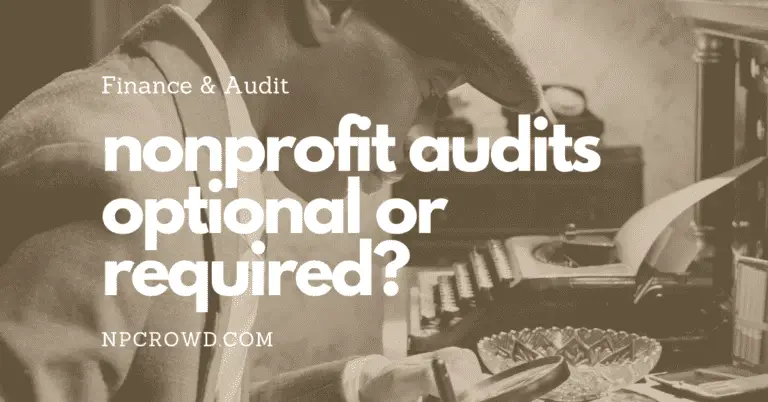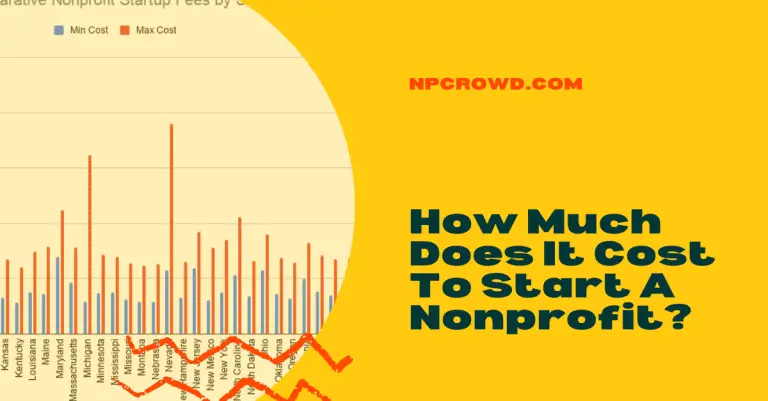Fiscal Sponsorship: Overlooked Nonprofit Startup Option Explained
Disclaimer: This post may contain affiliate links. These links, if used and purchases made, we may earn a small commission. These affiliate programs do not impact the recommendations we make or the resources we refer you to. Our focus is on providing you the best resources for your nonprofit journey.
Are you thinking about starting a nonprofit organization? Have you considered all of your options? One option that you may not have considered is fiscal sponsorship.Fiscal sponsorship is when a charity (nonprofit) agrees to help oversee a new project or organization that shares its mission. This arrangement is usually made so the new organization can further the sponsoring charity’s goals. The new project or organization is called a fiscal sponsor project. The sponsoring charity takes on some legal and financial responsibility for the project and usually provides the project with 501(c)(3) status.
Fiscal sponsorship can be a great option for new nonprofits, especially when someone asks how to start a nonprofit organization with no money. Before you enter into a fiscal sponsorship arrangement, be sure you understand what they are, are not, and the benefits and drawbacks.
Let’s dive in and learn about fiscal sponsorships.
What is fiscal sponsorship?
Fiscal sponsorship is a formal arrangement in which a 501(c)(3) public charity agrees to provide limited financial and legal oversight of a new project or organization that shares its charitable mission. The project or organization, known as a fiscal sponsor project, is typically a program or activity that furthers the sponsoring organization’s exempt purpose.
Under a fiscal sponsorship arrangement, the sponsor organization:
- Has a formal written agreement with the project or organization
- Retains legal and fiduciary responsibility for the project or organization
- Has primary control over the project or organization’s funds
- Provides the project or organization with 501(c)(3) status, if it does not already have it
A fiscal sponsor can be a good option for a new project or organization that:
- Is not yet eligible for 501(c)(3) status
- Is in the process of applying for 501(c)(3) status
- Does not want to go through the hassle and expense of applying for 501(c)(3) status
- Does not want to be a standalone 501(c)(3) organization
What are the benefits of fiscal sponsorship?
There are several benefits of fiscal sponsorship:
- The project or organization can immediately start fundraising as a 501(c)(3) public charity
- The project or organization does not have to go through the hassle and expense of applying for 501(c)(3) status
- The project or organization can tap into the resources and infrastructure of the sponsoring organization
- The project or organization can benefit from the sponsoring organization’s expertise
What are the drawbacks of fiscal sponsorship?
There are also several drawbacks of fiscal sponsorship:
- The project or organization is legally and financially accountable to the sponsoring organization
- The project or organization may have less control over its own affairs
- The project or organization may have to pay a fee to the sponsoring organization
- The project or organization’s 501(c)(3) status may be at risk if the sponsoring organization’s tax-exempt status is revoked
- Leaving the sponsorship while continuing the project can become messy
How does fiscal sponsorship work?

There are two main types of fiscal sponsorship arrangements:
Type I – Direct Model:
This is the most common model where the sponsored project is fully integrated into the sponsoring organization’s operations. The fiscal sponsor is legally and financially responsible for the project or organization.
Other characteristics of the Direct model may include
- The sponsored project or organization is typically a program or activity of the sponsoring organization.
- Funds are commingled between the sponsored project or organization and the sponsoring organization’s funds.
- The sponsored project or organization does not have its own 501(c)(3) status.
- The sponsored project or organization does not have its own governing board.
- Typically the sponsored project or organization is not legally separate from the sponsoring organization.
Pros and Cons of Type I – Direct Model
Some of the following benefits of the Direct model are why it is the most popular model for nonprofit fiscal sponsorship:
- It is easier to integrate the project or organization into the sponsor’s existing operations since it is simply a program or activity of the sponsoring organization.
- Accounting may be easier for the sponsor as they manage the project or organization’s finances since funds are comingled within the sponsoring organization.
- The sponsored project or organization does not have to go through the hassle and expense of applying for 501(c)(3) status.
While it is the most popular, the Direct model does have some inherent drawbacks depending on your goals and situation.
- The sponsored project or organization does not have its own 501(c)(3) status. This means that the project or organization cannot solicit tax-deductible donations on its own. This may be considered a risk long-term if the plan is to launch as a separate entity later.
- The sponsored project or organization does not have its own governing board. This means that the sponsor has ultimate control over the project or organization.
- There is an additional risk for the sponsor since the sponsored project or organization is not legally separate from the sponsoring organization. This means that the sponsor is legally responsible for the actions of the project or organization.
Type II – Grant Model:
In this model, the sponsored project or organization is legally separate from the sponsoring organization and has its own 501(c)(3) status. The fiscal sponsor is legally responsible for the project or organization, but the project or organization is financially responsible for itself. The fiscal sponsor still receives funding for the project and then passes that through to the project.
Other characteristics of the Grant model are:
- The sponsored project or organization’s funds are not commingled with the sponsoring organization’s funds
- The sponsored project or organization has its own 501(c)(3) status.
- The sponsored project or organization has its own governing board.
- The sponsored project or organization is legally separate from the sponsoring organization.
The fiscal sponsor continues to be responsible for the directing of funds received and accountable for their use. However, the project has more authority and control over its program and operates more independently from the fiscal sponsor organization.
Pros and Cons of Type II – Grant Model
When looking at the Grant model, there are some potential benefits to review. These may include:
- More financial control for the sponsored project or organization may be gained since funds are not commingled with the sponsoring organization’s funds.
- The sponsored project or organization has its own 501(c)(3) status. This means that the project or organization can solicit tax-deductible donations on its own.
- Since the sponsored project or organization has its own governing board it will have more control over the activities it conducts.
- The sponsored project or organization is legally separate from the sponsoring organization. This means that the sponsor is not legally responsible for the actions of the project or organization.
Depending on your situation, the Grant model may also have some drawbacks including:
- Since the sponsored project or organization’s funds are not commingled with the sponsoring organization’s funds it may be more difficult for the sponsor to manage the project or organization’s finances.
- The sponsored project or organization has to go through the hassle and expense of applying for 501(c)(3) status. This can be a time-consuming and expensive process.
Considerations
Under either type of arrangement, the fiscal sponsor must exercise due diligence in selecting projects or organizations to sponsor. The sponsor must also have a written agreement with the project or organization that sets forth the rights and responsibilities of both parties.
The fiscal sponsor will typically assess a fee on all funds applied to or granted to the sponsored project. These fees are typically in the 5-15% range although lower and higher rates can be reasonably argued depending upon the specifics of the arrangement.
Fiscal Sponsorship: 6 Ways To Do It Right
Gregory L. Colvin (Author)
“Greg Colvin’s book remains an essential part of the library of every grantseeker considering some form of fiscal sponsorship.” – Kirke Wilson, Former President, Rosenberg Foundation
“Excellent resource, very clear explanations. Have a copy for myself and have given copies to clients. You have to be careful to set up fiscal sponsorships the right way; whether you are the sponsor or are the party being sponsored, do yourself a favor and read this book.” – Amazon reviewer
Who keeps insurance coverage in a fiscal sponsorship?
The fiscal sponsor is typically responsible for maintaining adequate insurance coverage for the project or organization. Typical coverages include:
- General liability
- Directors and officers liability (D&O)
- Professional liability
- Employment practices liability
The project or organization should be named as an additional insured on the sponsor’s insurance policies.
Who is legally responsible for the project or organization?

Under a fiscal sponsorship arrangement, the fiscal sponsor is legally responsible for the project or organization. This means that the sponsor is liable for the actions of the project or organization, and the sponsor’s assets are at risk if the project or organization is sued.
Each agreement can clearly alter the liabilities and responsibilities to some extent and so it is important to consult legal counsel to help determine what is best for your specific arrangement.
The risks to be considered include:
- Liability for the actions of the project or organization
- Liability for the actions of the sponsor’s employees, if they are working with the project or organization
- Liability for the actions of volunteers, if they are working with the project or organization
- Liability for the actions of the project or organization’s employees, if they are not also employees of the sponsor
How can I find a fiscal sponsor for my project?
Finding a fiscal sponsor is not necessarily an easy process, however, there are a few avenues you can explore.
A few different ways to find a fiscal sponsor for your project:
- Search the internet: A simple Google search for “fiscal sponsor” + your city or state should turn up a few options.
- Check with your local community foundation: Many community foundations offer fiscal sponsorship services.
- Ask around: Talk to other nonprofit organizations in your community to see if they know of any fiscal sponsors.
- Talk with nonprofit lawyers and accountants that have experience in your nonprofit space. They may have knowledge about potential nonprofits that could be approached about fiscal sponsorship.
You may also want to review the Fiscal Sponsor directory which has an impressive list of U.S. Based fiscal sponsor organizations.
What should I look for in a fiscal sponsor?

When choosing a fiscal sponsor, it is important to make sure that the sponsor is a good fit for your project or organization. Some things to consider include:
- The sponsor’s mission: Make sure that the sponsor’s mission is compatible with your own.
- The sponsor’s size: A large sponsor may have more resources to offer, but a small sponsor may be more nimble and responsive to your needs.
- The sponsor’s reputation: Talk to other nonprofits in your community to see if they have had any experience with the sponsor.
- The sponsor’s policies: Make sure that you understand the sponsor’s policies on things like insurance, disbursement of funds, and conflict of interest.
How to prepare before asking for a fiscal sponsorship
The most important thing you can do before reaching out to a fiscal sponsor is to have a well-developed project or organization. This means having a clear and concise mission statement, goals and objectives, and a detailed project or business plan.
You should also have a solid understanding of the financial needs of your project or organization and how the fiscal sponsorship arrangement will work.
Preparing these materials will not only make it easier to find a fiscal sponsor, but it will also make it more likely that your sponsorship arrangement will be successful.
Why is a written agreement really needed in a fiscal sponsorship?
It is important to have a written agreement with your fiscal sponsor. Why? Well, there are several reasons. Let’s look at a few ways a written agreement helps a fiscal sponsorship:
- A written agreement will help to ensure that there is a clear understanding between you and your sponsor about the rights and responsibilities of each party.
- A written agreement can help to protect you in the event that something goes wrong. For example, if the sponsor mismanages your funds, a written agreement can help you to get your money back.
- A written agreement can help to resolve any disputes that may arise between you and your sponsor.
When crafting the agreement don’t forget to think about the end of the sponsorship. What I mean by that is making sure you clearly outline when the relationship can be terminated and who retains ownership of the project, assets, intellectual property, and donor information.
Remember that the fiscal sponsor is collecting the donor information since they are responsible for the financial components of the sponsored project or organization. What happens to the donor data when the project or organization launches as a separate entity, disbands or the sponsorship is terminated?
These are all important considerations that should be addressed in the written agreement.
What should be included in a fiscal sponsorship agreement?
Here are some things that you may want to include in your fiscal sponsorship agreement:
- The name and contact information of the sponsor and the project or organization
- A description of the project or organization and its purpose
- The term of the agreement
- The duties of the sponsor
- The rights of the sponsor
- The duties of the project or organization
- The rights of the project or organization
- How funds will be disbursed – method, frequency, percentages for administrative fees
- How the agreement can be terminated
- Insurance coverages including umbrella, liability, D&O, etc…
Who is responsible for audit requirements in a fiscal sponsorship?
The fiscal sponsor is responsible for ensuring that the project or organization meets all applicable audit requirements. This includes preparing and filing the project or organization’s Form 990, as well as any other required financial reports.
The fiscal sponsorship agreement will explain how the sponsor and project or organization will handle the audit requirements.
For example, if the organization project organization has received its 501(c)(3) status, the agreement may state that the sponsor will prepare and file the Form 990 on behalf of the project or organization. Or, the agreement may state that the project or organization will be responsible for its own Form 990, but that the sponsor will provide assistance as needed.
Wrap Up
Fiscal sponsorship can be a great option for new projects and organizations that are not yet eligible for 501(c)(3) status. It can also be a good option for projects and organizations that do not want to go through the hassle and expense of applying for 501(c)(3) status.
When choosing a fiscal sponsor, it is important to select an organization that shares your mission. It is also important to have a well-developed project or organization. Preparing these materials will not only make it easier to find a fiscal sponsor, but it will also make it more likely that your sponsorship arrangement will be successful.
Once you have selected a fiscal sponsor, it is important to have a written agreement that sets forth the rights and responsibilities of both parties. The agreement should also address how the audit requirements will be handled and what will happen to the project or organization’s assets, intellectual property, and donor information if the sponsorship arrangement is terminated.
Resources
- https://fiscalsponsorship.com/
- https://fiscalsponsordirectory.org/
- https://www.sfbar.org/wp-content/uploads/2019/10/fiscal-sponsor-memo.pdf
- https://www.councilofnonprofits.org/tools-resources/fiscal-sponsorship-nonprofits
- https://neophilanthropy.org/fiscal-sponsorship/








